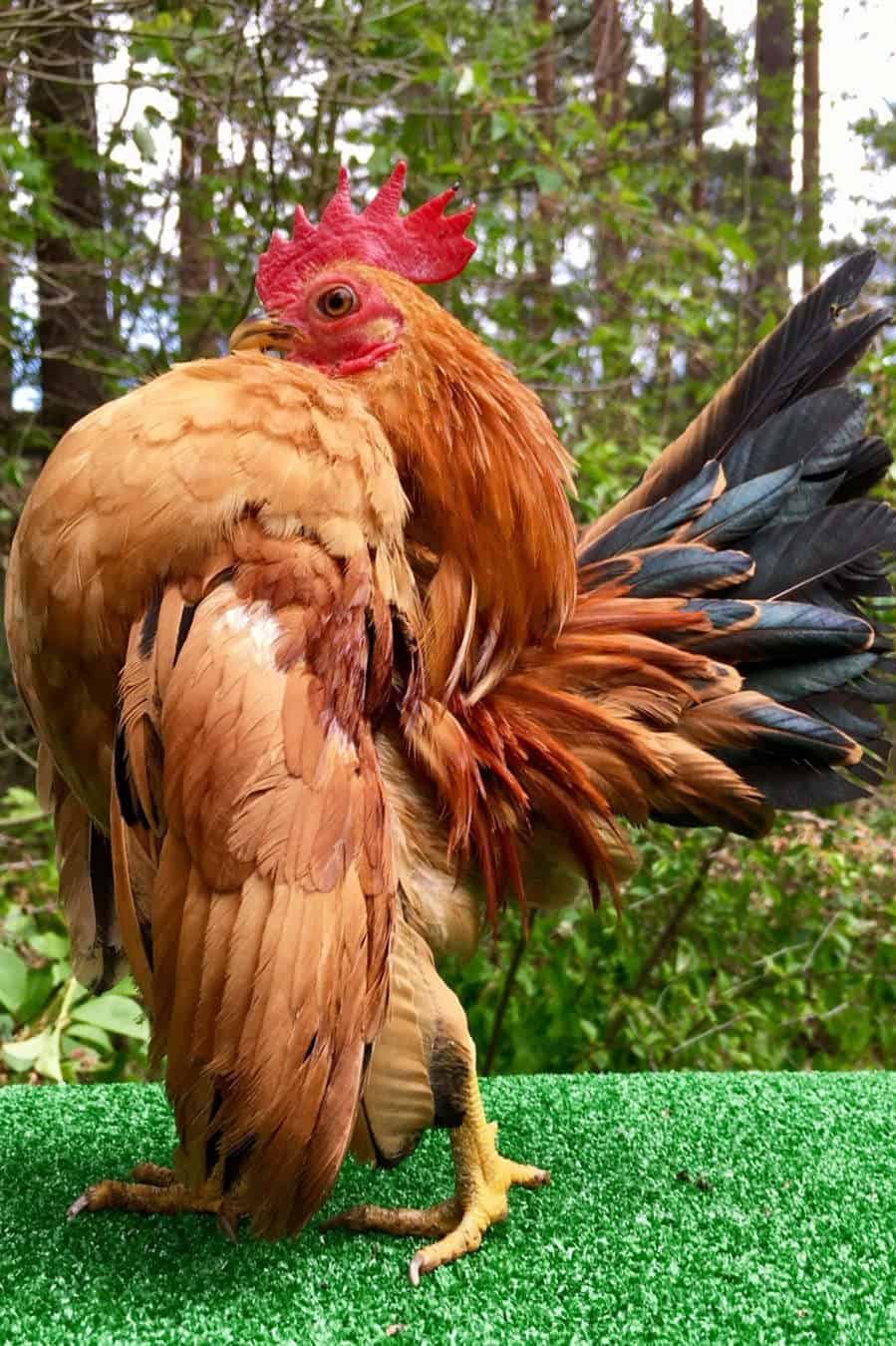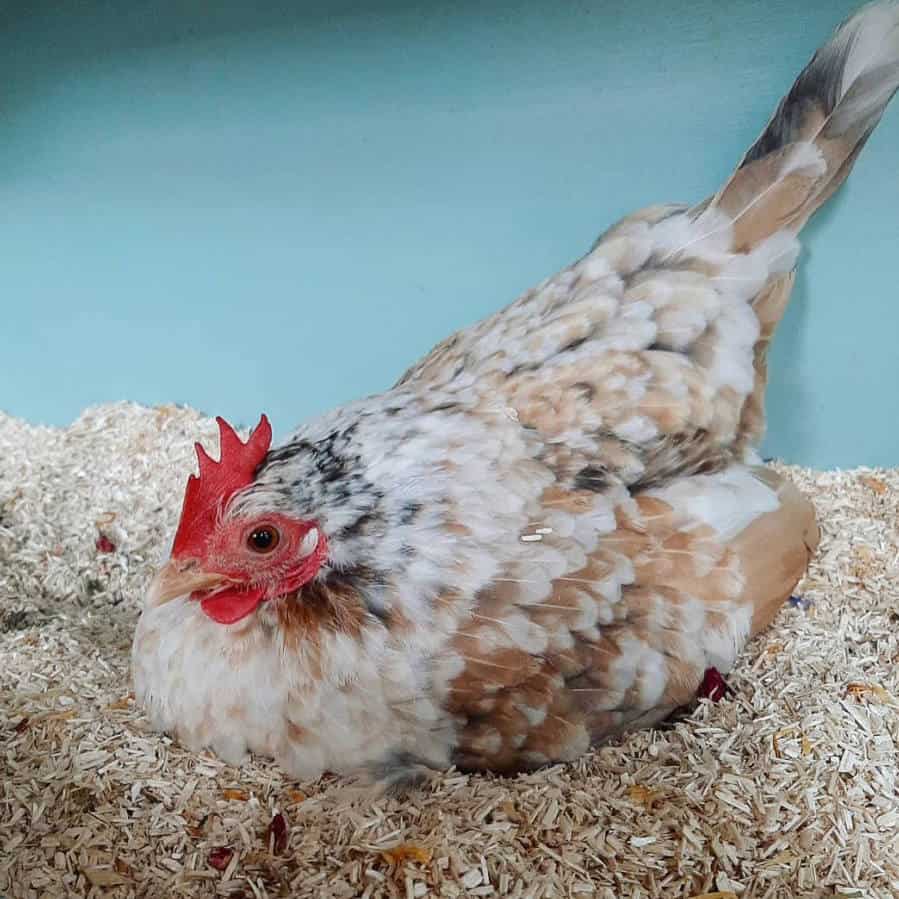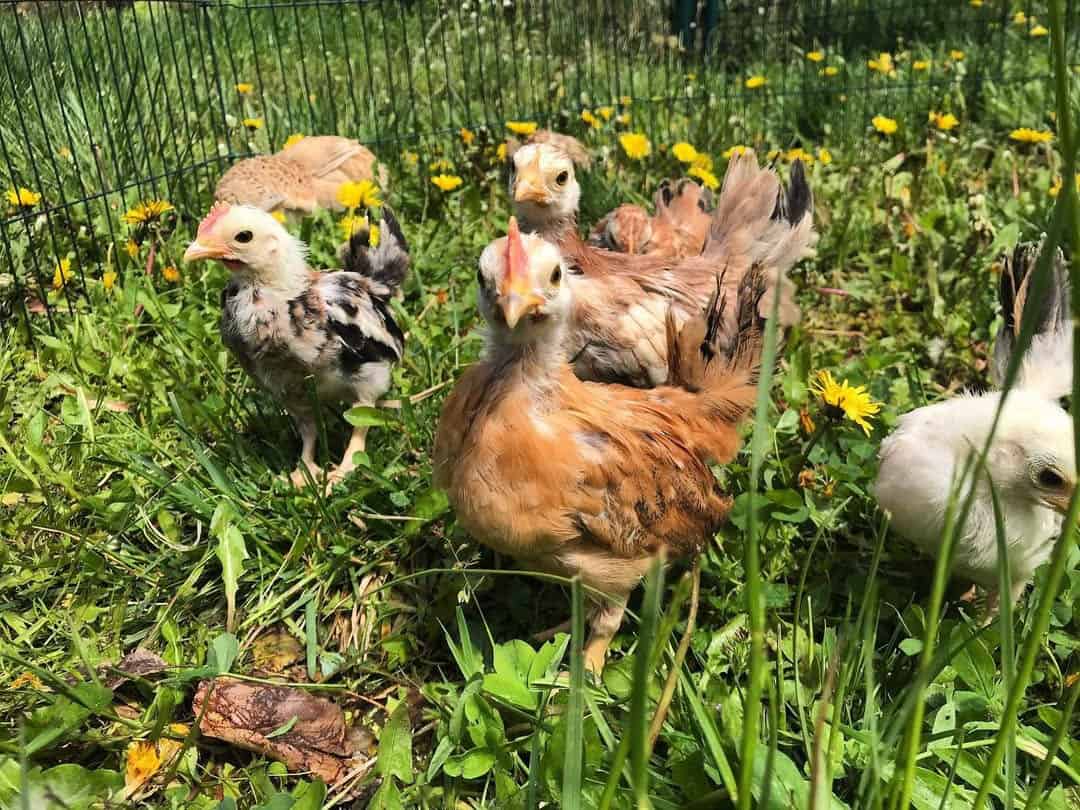One of the most fascinating breeds of chicken is a fairly new breed, called the Serama. These tiny birds have a unique appearance and are also considered to be incredibly friendly and gentle. Combined, these attributes make the Serama a popular choice for anyone who is enthusiastic about raising chickens.

Serama Chicken Overview
| Feature | Details |
| Purpose | Ornamental |
| Egg Color | Cream
Brown |
| Egg Size | Small |
| Broodiness | Moderately to Very Broody |
| Heat Tolerance | Yes |
| Cold Tolerance | No |
| Comb Type | Single Comb |
| Egg Production | About 180 to 200 eggs per year |
| Chicken Skin Color | Yellow |
| Life Span | 7-10 years |
| Adult Weight | Hen: 0.6-0.9 lbs, Rooster: 0.8-1.1 lbs |
| Backyard Friendly | 5/5 |
Chickens might be the last thing you think about when finding a pet. As finding the right breed for small spaces and apartments can be hard for many chicken enthusiasts, we’re here to introduce you to the Serama breed!
The Serama chicken is a breed that has won over many poultry enthusiasts around the world for its amazing looks, sociable personality, and minuscule size. These little charmers have become popular pets as well as exhibition and show birds in countries from their native home of Malaysia to other places such as the United States, Australia, and Europe.
Though they might not lay lots of eggs nor provide much meat when it comes to the kitchen table, these fowl shine in the areas of ornamental and as a pet. Seramas are oftentimes an excellent match for smaller homesteads; since their size differs so vastly from that of your standard laying hens and would-be-roasters.
One more thing children can appreciate about these miniatures? Broodiness! It’s fair to say that most hens belonging to this breed will be found delightedly setting on eggs without hesitation. Even without the typical high egg production or meat yields that could be expected from larger breeds, it’s no secret why Seramas are prized throughout many households!
Background and History of Serama Chickens

The Serama is a relatively new chicken breed, only truly emerging about 50 years ago. Some stories about the breed suggest that it was originally given as a gift during ancient times to the king of Thailand, but it is unclear if this story is truly about the Serama breed or simply about another type of small, or bantam, chicken.
The breed as it is known today originated in Malaysia. The breed’s origins started as early as the 1600s, but the modern strain started in the 1970s and was propagated by Wee Yean Een, a Malaysian breeder working in the province of Kelantan.
The Serama was created when Japanese bantams and Malaysian bantams were crossed. The Serama breed was first shown in 1990 and first came to the United States in 2000.
Since it was first imported into the United States, the American Serama chicken variety has been recognized by both the American Bantam Association and the American Poultry Association. There are several different clubs within the United States that work to preserve the breed and uphold the breed appearance standard.
Serama chickens were also imported into Europe in 2004 when they were brought into the United Kingdom. Since then, the Poultry Club of Great Britain has also recognized the breed. Despite this, Seramas are still relatively rare in Europe.
Seramas are available in a variety of colors, many of which are recognized, as well as sizes and even feather types. Because of this, many breeders stick to breeding a certain style of Serama chickens.
However, most enthusiasts prefer to have several types of Seramas because they are so fascinating and can add so much variety and interest to a flock.
Serama Chicken Breed Standard

- Seramas weigh between 13 and 19 ounces
- The body is V-shaped and erect
- Available in a variety of colors
Serama chickens are incredibly striking in appearance, for a variety of reasons. First, they are quite small. They are considered by many to be the smallest chicken breed on the planet. They range from between six and ten inches tall, and three weight classes are recognized for the breed standard.
The weight classes are Micro, where females weigh up to eight ounces and males weigh up to 13 ounces, A-Class, where females weigh under 12 ounces and males weigh under 13 ounces, B Class, where females weigh under 15 ounces and males weigh under 16 ounces, and C Class, where females and males both weigh under 19 ounces.

Serama chickens are available in a range of different colors, and many of these, including white and black, are recognized in different poultry associations. Seramas can also have different feather types. In Malaysia, only chickens with normal feathers, which are held tight to the body, are accepted.
However, in other areas, the United States in particular, silky or frizzle feathered birds are also considered to be acceptable.
The Serama body structure is as important as its size, and in Malaysia, Seramas are classified in accordance with their shape. These chickens stand very tall, with their heads held erect and their full chests puffed out.
They have a very short back, which gives them a V-shape. The wings add to this appearance as they are held downward and nearly point to the ground. The tails are held high.
Seramas have a single red comb and red wattles. Male Seramas have much larger combs and wattles than females. The legs of the birds are yellow and are not feathered.
Personality and Temperament of Serama Chicken
Although they look quite fierce with their erect, alert stance and strong chests, Seramas are some of the friendliest chickens available. They enjoy being patted and may even ask to be picked up. Many people keep them simply as pets since they are not well-suited for either laying eggs or producing meat.
Serama chickens have strong personalities, which makes them an interesting addition for any chicken enthusiast. However, because they are so gentle and friendly, they are very easy to care for. They can be kept indoors, and they do well with children. The docile nature of this chicken breed also makes them a good option for showing.
Serama chickens are also much quieter than the common chicken. The females make less noise than other hens. The males are also more docile than the average rooster and have a soft, nearly squeaky crow that is much less disruptive than the more familiar crow of an average rooster.
Roosters of the Serama breed can sometimes become aggressive when housed with other roosters, so it is best to house them with hens only.
Serama Chicken Egg Laying

- Produce four to five eggs a week
- Eggs are cream or brown in color
- Eggs are much smaller than traditional chicken eggs
Despite their tiny size, Serama chickens are actually quite good at laying eggs. They tend to lay about four eggs a week, for a total of around 200 to 208 eggs a year. However, these eggs are as small as the parent birds. It takes about five Serama eggs to add up to a regular chicken egg’s size.
Serama hens begin producing eggs at around five months old. The eggs are generally cream colored but can range from light to dark brown as well. Hens lay all year long, although it has been noted that they tend to produce more eggs between November and February.
Seramas are quite broody, meaning they are doting mothers, and they are invested in hatching their eggs. Serama hens can only sit on about four or five eggs at a time due to their size. The eggs hatch faster than those of larger chickens, with chicks emerging after 19 or 20 days. The smaller varieties of Seramas may hatch even faster.
Health Issues and Care

Serama chickens are a relatively hardy breed and therefore are less prone to particular illnesses than any other chicken breed. As long as they are given adequate space and provided with a nutritious diet, Serama chicken can live between seven and 10 years old.
Like any other chicken, the Serama chicken is susceptible to the avian flu. In fact, the breed’s population was badly damaged when the avian flu swept through Malaysia.
In order to prevent contact with the avian flu, keepers of Serama chickens should take care to limit the amount of exposure to wild birds that their chickens have. Aviaries, nest boxes, and anywhere else the chickens might roam should be kept clean in order to discourage germs.
Serama chickens have also inherited, from their Japanese bantam ancestors, a gene that can cause developmental problems in chicks before they hatch from the egg.
This gene causes the legs of the chicks to grow to an inadequate length, which means the chicks cannot move around into a proper hatching position. This causes about a quarter of all Serama chicken eggs to fail to hatch.
3 Tips for Raising Serama Chickens
- The feed should consist of crumbles or mash
- Seramas should be kept away from drafts and dampness
- Seramas should be kept safe from predators
Serama chickens are relatively easy to keep, whether they are kept indoors or outdoors, and they need less space and less food than the average chicken. However, Serama chicken owners should keep the bird’s small size and tropical origins in mind when creating the correct setup.

Because they are so small, Serama chickens can’t eat pellets as regular chickens do. Instead, these birds should be fed either mash or crumbles. Seramas are also good at foraging, and allowing the birds to free-range can introduce healthy, nutritious insects into their diets. This can increase the number of vitamins and minerals the birds are receiving.
Seramas come from a warm climate and are therefore not particularly suited to colder weather. They can withstand winters as long as temperatures do not drop below 40 degrees Fahrenheit.
However, no matter what the weather, it is important to keep these chickens away from drafts, as this can cause the birds to catch a chill. In addition, these birds do not do well in muddy or damp conditions. Instead, they can be kept indoors or on grass.
Since they are so small, these chickens are also quite susceptible to predators. Keeping Serama chickens inside can mitigate the risk of predators. However, if the birds are kept outside, it is vitally important that keepers ensure that the aviary or encloser is incredibly secure and that no predators, including foxes, hawks, owls, snakes, or rats, can make their way inside.
Summary
For those chicken enthusiasts who simply love birds and are looking for a pet or ornamental chicken, the Serama is an excellent choice. These birds are friendly, loving, and gentle, and they are also very interesting to look at. A flock of Seramas will be the envy of nearly anyone who likes chickens.


Joseph Hudson has been raising chickens for over 15 years. In 2018, he completed the Agriculture & Natural Resources program at Mt. San Antonio College. He currently raises over 1400 chickens on his 7.5-hectare farm. He keeps sharing his experience on raising healthy and happy chickens on Chicken Scratch The Foundry.







They are a great family unit. I have 2 roosters and 5 hens and they stay together while foraging. They tend to keep to themselves and stay away from the larger chickens, turkeys and guinea fowl. They love going into Moe Mo’s, (my mini horse) field and hanging out with him. Each has its own personality and are friendly. One I call Whitey will come when called as he knows his name. We just hatched out 6 of our 10 eggs and will start a second flock. We will also be looking for someone to trade with to gain new blood into the flock. If you simply want chickens to watch running around your places, these are perfect. Very little mess in the coop and cheap to feed.
Hello we also have a few and will be look to do a swap to change our blood line as well
I want to know where I can get the smaller breed of SERAMA CHICKENS. The under 12 oz Variety. The smallest ones I can get. Straight feathers,, no silkie or frizzle mix. Breeders name and e-mail address, and phone #.
Go to Facebook and search Jerry’s seramas llc.
I will be breeding my malaysian pair at anytime now. If interested, test at 716-533-8968
Any results
I’m currently starting to expand my serama flock. White hens over a black/mottled rooster. Straight & frizzles. Producing a variety of different colors and patterns. Chicks available. North Florida location
Happy to help you on your search for your Seramas. NPIP and AI clean. Florida, U.S.A. Shipping available.
https://www.facebook.com/groups/873433210085503/?ref=share_group_link
or
http://www.diamondseramas.com
Sent a request to join group
We hatched 2 baby Serama chicks about 10 weeks ago. We kept them inside in a brooder until a couple days ago. They are now outdoors in an enclosed coop and run – safe from any predators. They seem fine during the day, but as it starts getting dark, they seem to get frantic, like they’re looking for something or somewhere to go. So each night we pick them up and place them in their coop. But this is happening every night. Any ideas as to why they are getting frantic at dusk and won’t go into their coop on their own?
Hi Debbi,
It’s pretty common for young chicks, including Seramas, to be a bit disoriented when introduced to a new environment. They instinctively seek shelter at dusk but might be unsure of where to go in their new space. Here’s a quick checklist:
1. Roosting Bars: Do you have roosting bars in the coop? Chicks like to roost off the ground at night.
2. Lighting: A small, gradually dimming light can guide them into the coop as darkness falls.
3. Training: It might help to guide them to the coop each evening for a bit. They’ll catch on!
4. Coop Entrance: Make sure it’s easily accessible and visible to them.
5. Routine: Keeping a regular routine helps. They’ll get used to going in at night after a while.
I hope this helps! With a bit of patience, your chicks should soon understand where to head at dusk.